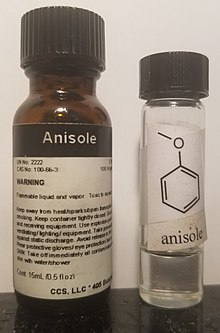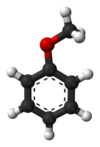| |||

| |||
| Names | |||
|---|---|---|---|
| Preferred IUPAC name
Anisole[1] | |||
| Systematic IUPAC name
Methoxybenzene[1] | |||
| Other names
Methyl phenyl ether[1]
Phenoxymethane | |||
| Identifiers | |||
3D model (JSmol)
|
|||
| 506892 | |||
| ChEBI | |||
| ChEMBL | |||
| ChemSpider | |||
| ECHA InfoCard | 100.002.615 | ||
| EC Number |
| ||
| 2964 | |||
| KEGG | |||
PubChem CID
|
|||
| RTECS number |
| ||
| UNII | |||
| UN number | 2222 | ||
CompTox Dashboard (EPA)
|
|||
| |||
| |||
| Properties | |||
| C7H8O | |||
| Molar mass | 108.140 g·mol−1 | ||
| Appearance | Colorless liquid | ||
| Density | 0.995 g/cm3 | ||
| Melting point | −37 °C (−35 °F; 236 K) | ||
| Boiling point | 154 °C (309 °F; 427 K) | ||
| Solubility | Insoluble | ||
| −72.79×10−6 cm3/mol | |||
| Hazards | |||
| GHS labelling: | |||
 
| |||
| Warning | |||
| H226, H315, H319 | |||
| P210, P233, P240, P241, P242, P243, P264, P280, P302+P352, P303+P361+P353, P305+P351+P338, P321, P332+P313, P337+P313, P362, P370+P378, P403+P235, P501 | |||
| NFPA 704 (fire diamond) | |||
| Lethal dose or concentration (LD, LC): | |||
LD50 (median dose)
|
3700 mg/kg (rat, oral) | ||
Except where otherwise noted, data are given for materials in their standard state (at 25 °C [77 °F], 100 kPa).
| |||
Anisole, or methoxybenzene, is an organic compound with the formula CH3OC6H5. It is a colorless liquid with a smell reminiscent of anise seed, and in fact many of its derivatives are found in natural and artificial fragrances. The compound is mainly made synthetically and is a precursor to other synthetic compounds. Structurally, it is an ether (−O−) with a methyl (−CH3) and phenyl (−C6H5) group attached. Anisole is a standard reagent of both practical and pedagogical value.[2]
- ^ a b c Nomenclature of Organic Chemistry: IUPAC Recommendations and Preferred Names 2013 (Blue Book). Cambridge: The Royal Society of Chemistry. 2014. pp. 702–703. doi:10.1039/9781849733069-00648. ISBN 978-0-85404-182-4.
Anisole, C6H5−O−CH3, is the only name in the class of ethers which is retained both as a preferred IUPAC name and for use in general nomenclature. For preferred IUPAC names, no substitution is allowed; for general nomenclature substitution is allowed on the ring and on the side chain under certain conditions (see P-34.1.1.4).
- ^ Smith, Michael B.; March, Jerry (2007), Advanced Organic Chemistry: Reactions, Mechanisms, and Structure (6th ed.), New York: Wiley-Interscience, ISBN 978-0-471-72091-1


